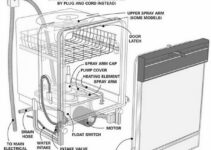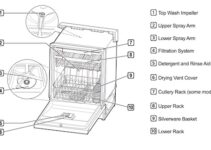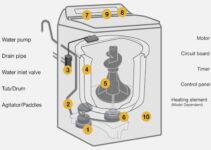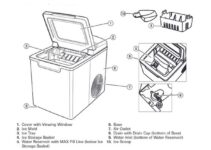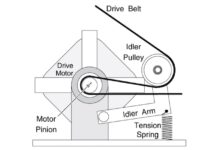The Samsung refrigerator water line is a hose or tube that connects the refrigerator to the water supply in a home or office. This line allows the refrigerator to dispense cold water and ice.
In this piece, you will find the Samsung refrigerator water line diagram and the details of the components.
Samsung Refrigerator Water Line Diagram
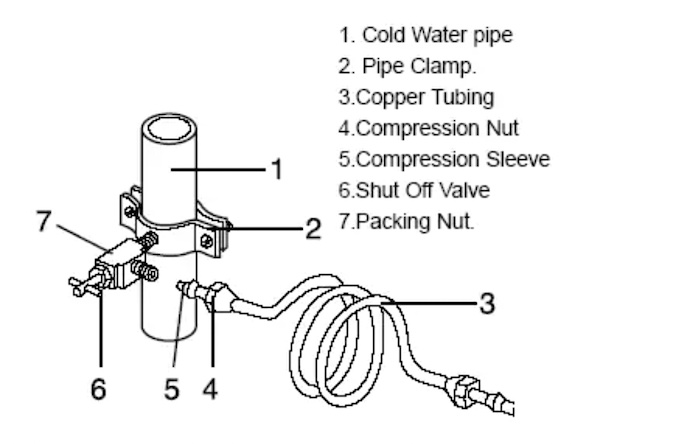
Samsung Refrigerator Water Line Details
Cold Water Pipe
The cold water pipe on a refrigerator is a pipe that carries cold water from the refrigerator’s water supply system to the ice maker or water dispenser. This pipe is typically made of copper or plastic and is insulated to maintain the water at a consistently cold temperature.
Pipe Clamp
The pipe clamp on a water supply kit is a device used to secure and stabilize a pipe in place. It is typically made of metal and has a tightening mechanism, such as a screw or bolt, that allows the user to securely clamp the pipe in place.
The pipe clamp is an important part of the water supply kit as it helps prevent leaks and ensures the stability of the pipes and fittings in the plumbing system.
Copper Tubing
The copper tubing on a water supply kit is a pipe made of copper that is used to transport water from the main water source to fixtures and appliances in a building or home.
Copper is a popular material for water supply lines because it is durable, corrosion-resistant, and has high thermal conductivity, which helps to maintain consistent water temperature. The copper tubing on a water supply kit is typically cut to the desired length and bent into the desired shape to fit the plumbing layout of the building or home.
Compression Nut
The compression nut is a component of a water supply kit that is used to secure the connections between pipes or fittings. It is typically made of brass or plastic and has threads on the outside that allow it to be tightened onto the fitting or pipe by hand or with a wrench. The compression nut creates a seal between the pipes or fittings to prevent water leakage.
Compression Sleeve
The compression sleeve on a water supply kit is a type of fitting that is used to connect two pipes together. It typically consists of a rubber or plastic sleeve that is inserted over the ends of the pipes and then tightened with a compression nut to create a watertight seal. The compression sleeve is used to prevent leaks and ensure that the water supply is properly connected and functioning.
Shut Off valve
The shut-off valve on a water supply kit is a valve that is used to control the flow of water from the water supply line to the water appliance or fixture. It is typically located near the appliance or fixture and is used to shut off the water supply in case of a leak or repair.
Packing Nut
The packing nut on a water supply kit is a component used to seal the connection between the supply line and the water supply valve. It is typically made of a durable material such as brass or stainless steel and is tightened using a wrench to create a tight seal and prevent leaks.
Water Cartridge Filter
A water filter cartridge is a replaceable filter that is installed in the water supply line of a refrigerator. Its purpose is to remove impurities and contaminants from the water before it is dispensed through the refrigerator’s water dispenser.
This helps to improve the taste and safety of the water for drinking and ice making. The cartridge needs to be replaced regularly according to the manufacturer’s instructions in order to maintain its effectiveness.
Common Samsung Refrigerator Problems and Fixes
Water leaking from the refrigerator
- Cause: clogged or frozen defrost drain, damaged water inlet valve
- Fix: Thaw out the defrost drain, replace the water inlet valve if damaged
Refrigerator not cooling
- Cause: faulty compressor, dirty condenser coils
- Fix: Replace the compressor, clean the condenser coils
Ice build-up in the freezer
- Cause: faulty defrost system, clogged defrost drain
- Fix: Replace the defrost system, thaw out the defrost drain
Refrigerator making noise
- Cause: loose or worn-out parts, debris in the condenser fan
- Fix: Tighten or replace the loose or worn-out parts, remove debris from the condenser fan
Door not closing properly
- Cause: misaligned door, damaged door gasket
- Fix: Adjust the door alignment, replace the door gasket if damaged
Water dispenser not working
- Cause: clogged water filter, faulty water inlet valve
- Fix: Replace the water filter, check and replace the water inlet valve if necessary
Refrigerator not defrosting
- Cause: faulty defrost system, blocked defrost drain
- Fix: Replace the defrost system, clear the defrost drain
Temperature fluctuations
- Cause: incorrect temperature settings, damaged thermostat
- Fix: Adjust the temperature settings, replace the thermostat if necessary
Refrigerator not lighting up
- Cause: faulty light switch, blown light bulb
- Fix: Replace the light switch, replace the light bulb
Door seal not sealing properly
- Cause: damaged door seal, misaligned door
- Fix: Replace the door seal, adjust the door alignment.
How to Maintain the Samsung refrigerator
- Keep the refrigerator clean by regularly wiping down the interior and exterior surfaces with a mild detergent and warm water.
- Keep the refrigerator door gasket clean and properly sealed to maintain proper temperature and energy efficiency.
- Avoid overloading the refrigerator with food, as this can cause the compressor to work harder and reduce its lifespan.
- Check the temperature settings and adjust them as needed to maintain optimal cooling temperatures.
- Replace the air filter every 6-12 months to ensure proper air circulation and prevent the buildup of bacteria and mold.
- Avoid placing hot or warm items directly into the refrigerator, as this can cause the compressor to work harder and reduce its efficiency.
- Keep the refrigerator away from direct sunlight and heat sources, as this can cause the compressor to work harder and reduce its efficiency.
- Avoid leaving the refrigerator door open for long periods of time, as this can cause the compressor to work harder and reduce its efficiency.
- Check the condenser coils regularly and clean them with a brush or vacuum as needed to ensure proper air circulation and cooling.
- If your refrigerator has an ice maker, regularly clean and sanitize the ice maker and replace the water filter as recommended by the manufacturer.
